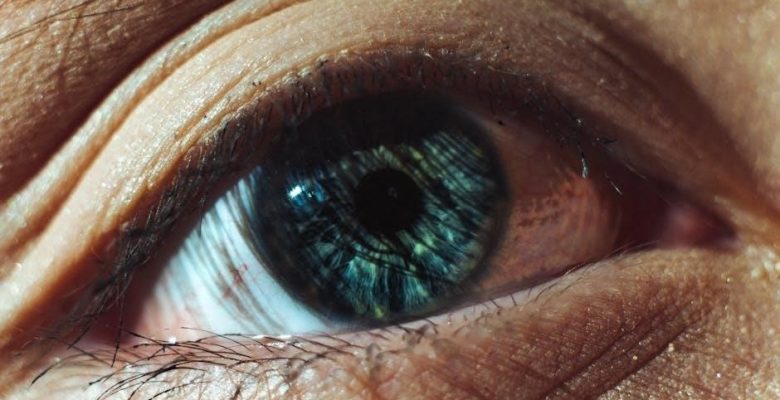anatomy and physiology for dummies pdf
Anatomy and Physiology for Dummies PDF is a user-friendly guide simplifying complex concepts. It covers essential topics like body systems‚ cells‚ and organs‚ making learning engaging. Ideal for students and curious learners‚ this resource offers clear explanations and practical examples to grasp human anatomy and physiology fundamentals.
What is Anatomy and Physiology?
Anatomy and physiology are the study of the structure and function of living organisms‚ focusing on how systems‚ organs‚ and cells work together. Anatomy explores the physical structure‚ while physiology examines how these structures function. Together‚ they provide a comprehensive understanding of how the human body operates. This field is essential for medicine‚ healthcare‚ and biology. The Anatomy and Physiology for Dummies PDF simplifies these complex topics‚ making them accessible to students and learners of all levels. It covers cells‚ tissues‚ organs‚ and systems‚ offering a clear and engaging introduction to the subject.
Why Study Anatomy and Physiology?
Studying anatomy and physiology helps understand how the human body functions‚ aiding in careers like healthcare‚ fitness‚ and science. It explains how systems interact‚ enabling better health management and informed decisions. This knowledge is vital for medical professionals‚ students‚ and anyone curious about bodily processes. The “For Dummies” guide makes complex concepts accessible‚ offering practical insights and real-world applications. By mastering these fundamentals‚ learners gain a deeper appreciation of human biology‚ empowering them to maintain wellness and address health challenges effectively. It’s an essential foundation for understanding life’s biological mechanisms.
Overview of the Anatomy and Physiology for Dummies Guide
The Anatomy and Physiology for Dummies guide is a comprehensive‚ user-friendly resource designed to simplify complex biological concepts. Authored by experts like Maggie Norris and Donna Rae Siegfried‚ it offers clear explanations and practical examples. The guide covers essential topics such as body systems‚ cells‚ tissues‚ and organs‚ making it ideal for students and general readers. It includes quizzes‚ exercises‚ and visual aids to enhance learning. Available in PDF format‚ this guide is accessible and engaging‚ providing a solid foundation for understanding human anatomy and physiology.
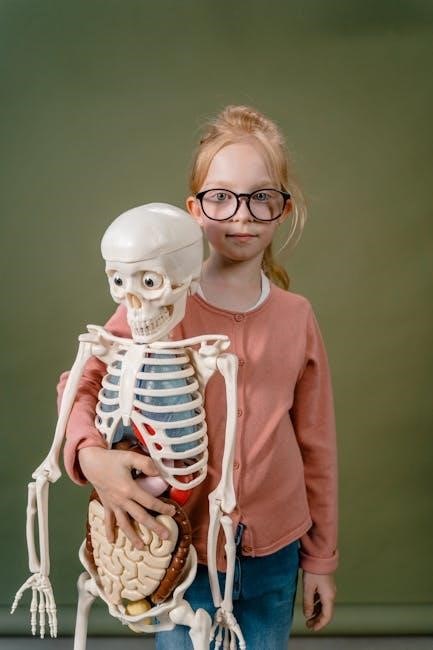
Key Concepts in Anatomy and Physiology
Anatomy and Physiology for Dummies PDF covers foundational concepts like body systems‚ cells‚ tissues‚ and organs. It simplifies complex topics‚ making learning easy and enjoyable for everyone.
The Human Body Systems
The human body is composed of 11 major systems working together to maintain life. These include the skeletal‚ muscular‚ nervous‚ circulatory‚ respiratory‚ digestive‚ endocrine‚ immune‚ urinary‚ and reproductive systems. Each system has unique functions‚ yet they interact to ensure overall health. For example‚ the circulatory system transports oxygen and nutrients‚ while the respiratory system facilitates breathing. The nervous system controls voluntary and involuntary actions‚ and the immune system protects against pathogens. Understanding these systems and their interconnections is crucial for grasping human anatomy and physiology‚ as emphasized in the Anatomy and Physiology for Dummies guide.
Cells and Tissues
Cells are the building blocks of life‚ forming the foundation of all biological structures. In Anatomy and Physiology for Dummies‚ cells are explored in detail‚ focusing on their structure‚ function‚ and role in maintaining life. Tissues‚ groups of specialized cells‚ are also discussed‚ highlighting their importance in forming organs and enabling bodily functions. The guide simplifies complex concepts‚ making it easy to understand how cells and tissues work together to sustain health and enable growth. This section provides a clear‚ engaging introduction to the microscopic world that underpins human anatomy and physiology.
Organs and Organ Systems
Organs are structures composed of two or more types of tissues that work together to perform specific functions. Organ systems‚ meanwhile‚ are groups of organs that collaborate to achieve common goals. For example‚ the heart‚ lungs‚ and blood vessels form the circulatory system‚ while the brain‚ spinal cord‚ and nerves make up the nervous system. These systems interact to maintain bodily functions like digestion‚ respiration‚ and movement. Understanding how organs and systems work together is crucial for grasping human anatomy and physiology‚ as it reveals how the body operates as an integrated whole to sustain life and overall health.

The Skeletal System
The skeletal system‚ comprising bones and joints‚ provides structural support and protection. The Anatomy and Physiology for Dummies PDF explains its functions‚ including movement and blood cell production‚ clearly.
Bones and Joints
Bones are rigid structures that form the framework of the human body‚ providing support‚ protection‚ and movement. They are categorized into long‚ short‚ flat‚ and irregular bones‚ each serving specific functions. Joints‚ where bones connect‚ allow for flexibility and mobility. Types of joints include synovial joints‚ which enable extensive movement‚ and fibrous joints‚ which are immobile. The skeletal system relies on bones and joints to facilitate locomotion‚ maintain posture‚ and protect internal organs. Understanding their structure and function is essential for grasping human anatomy and physiology. The guide simplifies these complex concepts for easy comprehension.
Muscular System Overview
The muscular system consists of three types of muscles: skeletal‚ smooth‚ and cardiac. Skeletal muscles enable voluntary movements‚ like walking‚ while smooth muscles handle involuntary actions‚ such as digestion. Cardiac muscle powers the heartbeat. Together‚ these muscles facilitate movement‚ maintain posture‚ and regulate body functions. The system works closely with the nervous and skeletal systems‚ ensuring coordinated actions. Understanding muscle structure‚ function‚ and disorders provides insights into overall health and mobility. This overview helps learners grasp the essentials of the muscular system and its vital role in the human body.
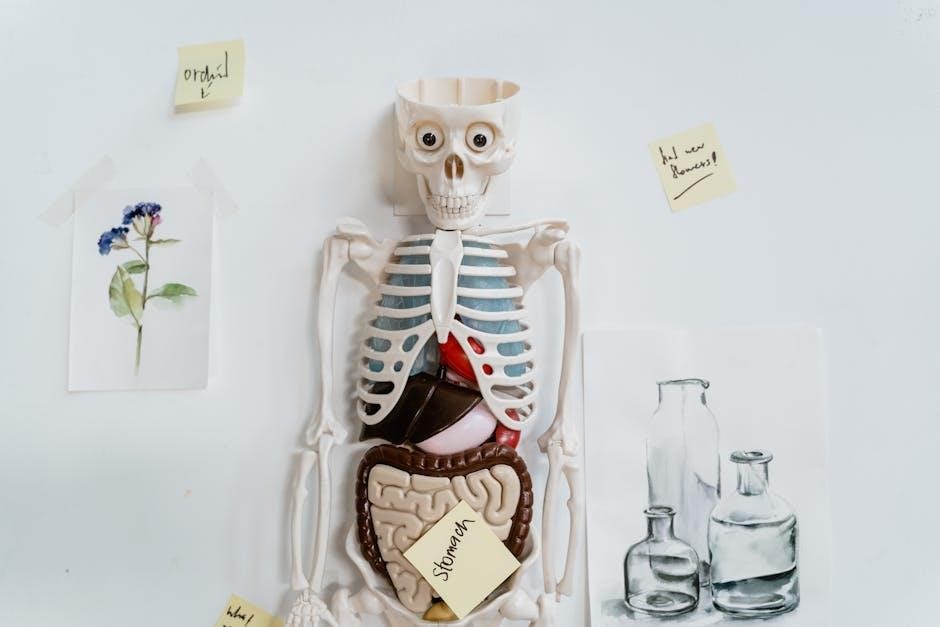
The Nervous System
The nervous system is a key area covered in the guide‚ enabling communication and control of body functions. It simplifies complex topics for easy understanding.
Structure and Function of the Brain
The brain is the control center of the body‚ responsible for regulating voluntary and involuntary functions. It consists of the cerebrum‚ cerebellum‚ and brainstem. The cerebrum processes sensory information‚ controls movement‚ and manages higher cognitive functions like memory and emotions. The cerebellum coordinates muscle movements‚ ensuring balance and posture. The brainstem connects the brain to the spinal cord‚ managing vital functions such as breathing‚ heart rate‚ and blood pressure. Cranial nerves originating from the brain regulate sensory and motor activities. The brain is protected by the blood-brain barrier‚ ensuring toxins are filtered out. Its intricate structure and complex functions make it essential for survival and consciousness.
Role of the Spinal Cord
The spinal cord is a vital part of the nervous system‚ acting as a pathway for nerve signals between the brain and the body. It plays a key role in controlling reflexes‚ such as withdrawing a hand from a hot surface‚ without involving the brain. The spinal cord also regulates involuntary functions like bladder control and bowel movements. It protects the body by transmitting pain signals to the brain and coordinates muscle movements‚ enabling walking and balance. Damage to the spinal cord can result in paralysis or loss of sensation‚ highlighting its importance in maintaining bodily functions and mobility.
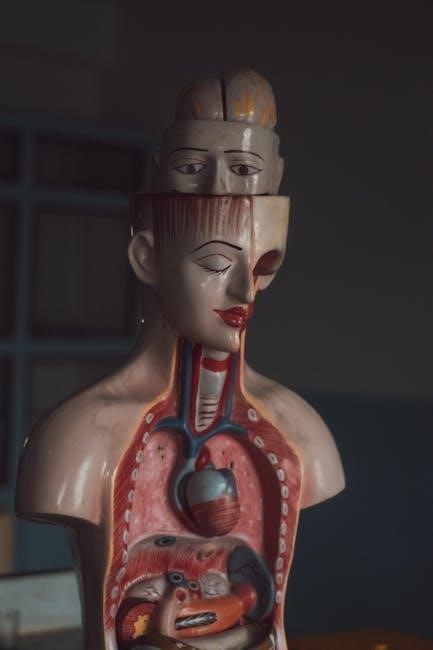
The Circulatory System
The circulatory system transports oxygen‚ nutrients‚ and hormones via blood vessels. It includes the heart‚ arteries‚ veins‚ and capillaries‚ ensuring vital functions and maintaining overall health.
Heart and Blood Vessels
The heart is a muscular organ that pumps blood throughout the body‚ while blood vessels include arteries‚ veins‚ and capillaries. Arteries carry oxygen-rich blood away from the heart‚ veins return oxygen-depleted blood‚ and capillaries facilitate nutrient and waste exchange. The heart’s structure‚ with its chambers and valves‚ ensures efficient blood circulation. Blood vessels regulate blood pressure and flow‚ maintaining homeostasis. Understanding these components is crucial for grasping how the circulatory system sustains life. The guide simplifies these complex processes‚ making them accessible for learners of all levels.
Blood Composition and Function
Blood is a vital fluid composed of plasma‚ red blood cells‚ white blood cells‚ and platelets. Plasma‚ the liquid portion‚ transports nutrients‚ hormones‚ and waste products. Red blood cells carry oxygen throughout the body‚ while white blood cells fight infections; Platelets are essential for blood clotting‚ preventing excessive bleeding. Together‚ these components maintain health by delivering oxygen‚ supporting immune responses‚ and enabling healing. Understanding blood’s composition and function is crucial for grasping overall physiology‚ as it connects various body systems. This topic is thoroughly explained in the Anatomy and Physiology for Dummies PDF‚ making complex concepts accessible.
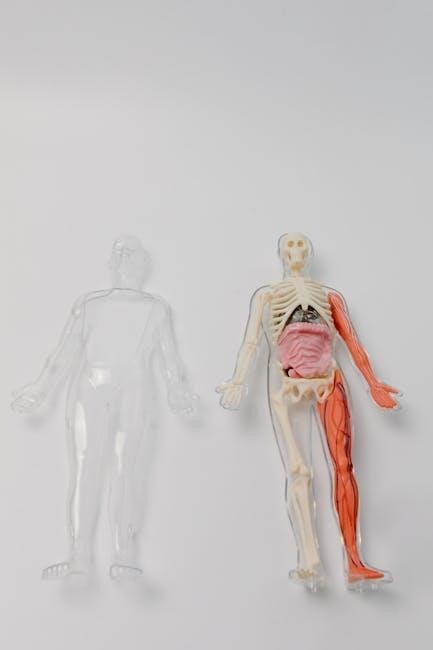
The Respiratory System
The respiratory system involves the nose‚ trachea‚ bronchi‚ and lungs‚ enabling oxygen intake and carbon dioxide expulsion. The Anatomy and Physiology for Dummies PDF explains how these structures facilitate gas exchange and breathing mechanics.
Lungs and Breathing Process
The lungs are vital organs responsible for exchanging oxygen and carbon dioxide through respiration. The breathing process begins with inhalation‚ as the diaphragm contracts and the rib cage expands‚ allowing air to enter the nasal or oral cavities. This air travels through the trachea‚ bronchi‚ and bronchioles into the alveoli‚ tiny sacs where gas exchange occurs. Oxygen diffuses into the bloodstream‚ while carbon dioxide is expelled during exhalation. The lungs’ elasticity and the rib cage’s movement facilitate this process‚ ensuring proper oxygenation of the body. This process is essential for cellular respiration and overall bodily function.
Oxygen and Carbon Dioxide Exchange
Oxygen and carbon dioxide exchange occurs in the alveoli of the lungs. Oxygen diffuses into blood through capillary walls‚ binding to hemoglobin in red blood cells. Carbon dioxide‚ a metabolic waste‚ travels from tissues to the lungs via the bloodstream. In the alveoli‚ it diffuses into the airspaces and is exhaled. This essential process maintains proper pH levels and energy production. The Anatomy and Physiology for Dummies PDF explains this mechanism clearly‚ highlighting its importance in respiration and overall bodily function. Efficient gas exchange is crucial for cellular respiration and sustaining life.

The Digestive System
Process of Digestion
Digestion involves breaking food into nutrients for absorption. It starts in the mouth‚ continues in the stomach‚ and finishes in the intestines with enzymes and acids.
Role of the Liver and Pancreas
The liver produces bile for fat digestion‚ while the pancreas secretes enzymes to break down carbohydrates‚ proteins‚ and fats‚ aiding metabolism and nutrient absorption efficiently.
Digestion begins with ingestion‚ where food enters the mouth. Mechanical digestion occurs through chewing‚ while salivary enzymes break down carbohydrates. The esophagus transports food to the stomach via peristalsis. In the stomach‚ gastric juices containing enzymes and acids further liquefy the food. The small intestine absorbs nutrients into the bloodstream. Pancreatic enzymes and bile from the liver and gallbladder aid in breaking down proteins‚ fats‚ and carbohydrates. The large intestine absorbs water‚ and the remaining waste forms stool for elimination. This process ensures proper nutrient absorption and waste removal‚ essential for overall health.
The liver and pancreas play vital roles in digestion and metabolism. The liver produces bile to break down fats‚ detoxifies harmful substances‚ and regulates blood sugar levels. It also stores glycogen for energy. The pancreas secretes digestive enzymes to break down carbohydrates‚ proteins‚ and fats. It also produces hormones like insulin and glucagon‚ which regulate blood sugar levels. Together‚ these organs ensure proper nutrient absorption and metabolic balance‚ making them essential for overall health and digestion. Their functions are crucial for maintaining energy homeostasis and supporting the body’s metabolic needs.

The Endocrine System
Hormones and Glands
Hormones regulate bodily functions‚ produced by glands like the pancreas‚ thyroid‚ and adrenal glands. They control metabolism‚ growth‚ and reproductive processes‚ ensuring overall physiological balance and health.
Hormones are chemical messengers produced by glands in the endocrine system. Glands like the pancreas‚ thyroid‚ and adrenal glands regulate various body functions. Hormones‚ such as insulin and adrenaline‚ control processes like metabolism‚ growth‚ and stress response. The pituitary gland acts as the “master gland‚” directing other glands. Understanding hormone production and function is crucial for grasping how the body maintains balance and responds to changes. This section simplifies the complex role of glands and hormones‚ making it accessible for learners.
Insulin and Diabetes Overview
Insulin‚ produced by the pancreas‚ plays a vital role in glucose regulation. It facilitates glucose uptake into cells‚ lowering blood sugar levels. Diabetes occurs when insulin production or function is impaired. Type 1 diabetes results from autoimmune destruction of insulin-producing cells‚ while Type 2 involves insulin resistance. The Anatomy and Physiology for Dummies guide explains these concepts clearly‚ helping readers understand the hormonal balance essential for maintaining health.
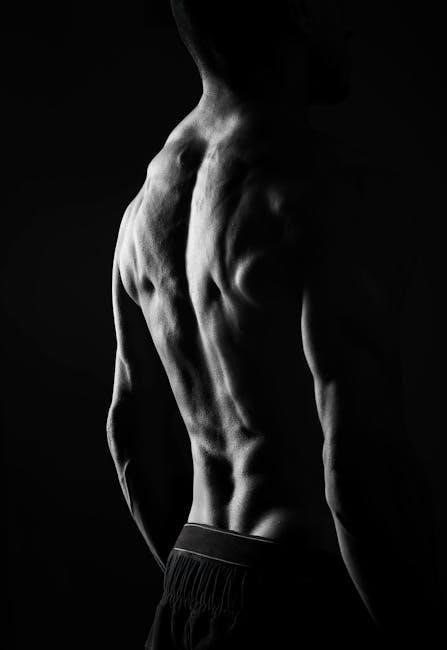
The Immune System
The immune system protects the body from pathogens. It includes white blood cells and the lymphatic system‚ explained in Anatomy and Physiology for Dummies PDF.
White Blood Cells and Their Functions
White blood cells (leukocytes) are crucial for immune defense‚ protecting the body from infections and diseases. They circulate in the blood and lymph‚ identifying and neutralizing pathogens. Key types include neutrophils‚ lymphocytes‚ monocytes‚ eosinophils‚ and basophils. Neutrophils engulf bacteria‚ while lymphocytes (B and T cells) coordinate immune responses. Monocytes mature into macrophages‚ cleaning up debris and pathogens. Eosinophils combat parasites and regulate allergic reactions‚ while basophils play a role in inflammation. Their functions are vital for maintaining health‚ making them a cornerstone of the immune system. Understanding their roles enhances appreciation for the body’s defense mechanisms.
Vaccines and Immunity
Vaccines play a crucial role in immunity by introducing harmless pathogens to trigger immune responses‚ building protection against diseases. The immune system recognizes and remembers these pathogens‚ enabling faster responses upon future exposure. Vaccines prevent outbreaks by promoting herd immunity‚ reducing disease spread; They are essential for public health‚ saving millions of lives annually. Understanding how vaccines work aligns with the principles of anatomy and physiology‚ highlighting the body’s defense mechanisms. This topic is explored in the guide‚ emphasizing the importance of immunization in maintaining health and preventing infectious diseases.
The Urinary System
The urinary system removes waste and excess fluids through urine production. Key organs include kidneys‚ ureters‚ bladder‚ and urethra‚ regulating electrolytes and maintaining pH balance effectively.
Kidneys and Urine Formation
The kidneys are vital organs responsible for filtering waste and excess fluids from the blood; Located in the lower back‚ they process blood to produce urine‚ which is then stored in the bladder. The nephrons‚ tiny functional units within the kidneys‚ perform filtration and reabsorption. Blood enters the glomerulus‚ where water‚ ions‚ and small molecules pass through to form filtrate. Tubules then reabsorb essential nutrients and water‚ regulating electrolyte balance. Proper kidney function is crucial for maintaining homeostasis‚ removing toxins‚ and managing blood pressure. Dysfunction can lead to conditions like kidney stones or chronic kidney disease.
Role of the Bladder and Ureters
The bladder is a hollow‚ muscular organ that stores urine until it is expelled from the body. Its elastic walls stretch to accommodate varying amounts of urine‚ typically holding up to 400-600 milliliters. The ureters‚ narrow tubes connecting the kidneys to the bladder‚ transport urine through peristalsis‚ ensuring one-way flow. These structures are essential for maintaining proper urinary function and preventing infection or backflow. Their coordinated roles are vital for the urinary system’s efficiency‚ ensuring waste removal and fluid balance in the body. This process is seamlessly regulated by the nervous system‚ enabling voluntary control over urination.
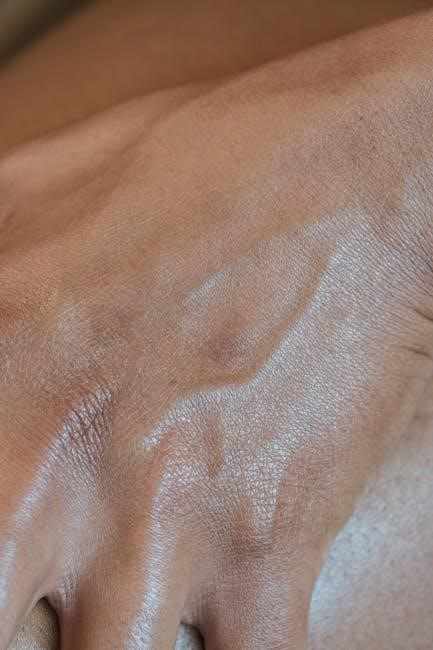
Reproductive System Basics
The reproductive system involves male and female organs designed for fertility. Anatomy and Physiology for Dummies PDF explains the roles of ovaries‚ testes‚ and hormone functions clearly.
Male and Female Reproductive Organs
The male reproductive system includes the testes‚ penis‚ and accessory glands like the prostate and seminal vesicles‚ which produce and transport sperm. The female reproductive system comprises the ovaries‚ uterus‚ fallopian tubes‚ and vagina‚ responsible for egg production‚ fertilization‚ and supporting pregnancy. Both systems are intricately designed for sexual reproduction‚ with hormones like testosterone and estrogen regulating their functions. Understanding these organs is crucial for grasping fertility‚ conception‚ and overall reproductive health. This section simplifies the complex structures and processes‚ making the topic accessible for all learners.
Fertilization and Pregnancy Overview
Fertilization occurs when a sperm fuses with an egg‚ forming a zygote. This process typically happens in the fallopian tube‚ triggering cell division and embryonic development. During pregnancy‚ hormonal changes support growth‚ with the placenta providing nutrients and oxygen. The embryo develops into a fetus‚ progressing through stages of organ formation and maturation. Anatomy and Physiology for Dummies PDF explains these processes clearly‚ highlighting the roles of the reproductive system‚ hormonal regulation‚ and the journey from conception to birth. This section simplifies complex biological events‚ making them easy to understand.
